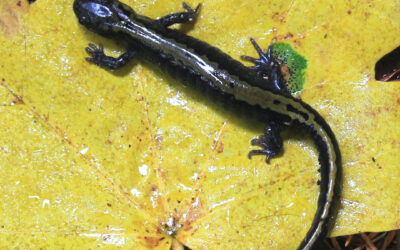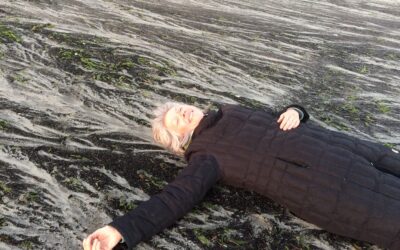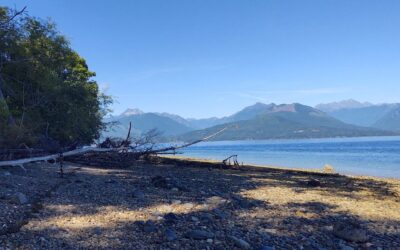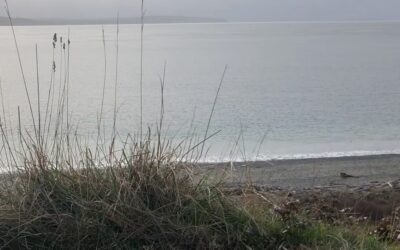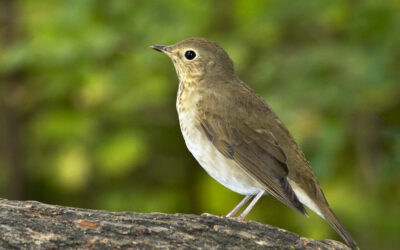The Singing Bullhead of the Salish Sea
by Andy Lamb, Autumn 2023

A small, recently deposited clutch of eggs with a pair of plainfin midshipman fish. One is overturned, showing its distinctive underside. photo by Linda Schroeder
The Singing Bullhead of the Salish Sea
by Andy Lamb
Autumn 2023
Perhaps the most colourful family member, the splendid toadfish is easily heard by night diving Scuba divers at Cozumel, Mexico. photo by Andy Lamb
Aside from whale calls, throughout human history we have believed that beneath the waves, it is silent. For example, Jacques Cousteau’s classic bestselling book and subsequent movie about exploring underwater were both titled The Silent World. More recently though, with dive exploration and ever increasing “listening” technology, we know this is false. The ocean is a very noisy place.
Among the fishes that are known to produce sound, the toadfish family Batrachoidae is noteworthy. This small group contains about 80 species, most of which live in the warmer seas of the western hemisphere. These bottom dwellers can generate sound via muscular contractions around air-filled swim bladders. Such vocalizations generally consist of humming, grunting, or croaking sounds that may be heard with unassisted ears.
Our Salish Sea representative is erroneously known as the singing (or roaring) bullhead. This plainfin midshipman (Porichthys notatus) is a typical toadfish in design and habitat. It grows to a length of 38 cm (15 in) and lives along the west coast, from central British Columbia, Canada, to southern Baja California, Mexico.
On the edge of the Salish Sea, a group from McMaster University (Ontario, Canada) — the Aquatic Behavioural Ecology Laboratory — has set up shop at the Pacific Biological Station in Nanaimo, B. C. Each spring and summer they study the plainfin midshipman at field sites in the Salish Sea under the leadership of Dr. Sigal Balshine.
 See more about McMaster University’s Aquatic Behavioural Ecology Laboratory and their work with the plainfin midshipman.
See more about McMaster University’s Aquatic Behavioural Ecology Laboratory and their work with the plainfin midshipman.
As a diver, beach comber, and Vancouver Aquarium collector, I have interacted with it for many years. And for the last 17 years, I lived on a Thetis Island beachfront blessed with excellent plainfin midshipman habitat.
For most the year, the plainfin midshipman lives in the subtidal zone and rests in, on, or slightly above, soft muddy substrates where Scuba divers may encounter it. Awaiting prey, this fish commonly buries with only its eyes and upturned mouth in view. At other times, it will float motionlessly with the aid of its air-filled swim bladder: perfect buoyancy control — as we divers would say.
Of no direct commercial importance, the plainfin midshipman is nonetheless commonly swept up as bycatch by trawlers — particularly in fine mesh shrimp gear. When discarded, individuals float at the surface as a result of over inflated swim bladders. Eager gulls swarm about gorging on these helpless castoffs.
In late April/early May, adult plainfin midshipman journey shallower and into the intertidal zone. This is a dangerous gauntlet. Here at Clam Bay, the harbour seal, river otter, mink, racoon, bald eagle, turkey vulture, osprey, great blue heron, common loon, common raven, northwestern crow, common merganser, and double-crested cormorant all partake of the feast. Likely this but a partial list.

A great blue heron with a plainfin midshipman. photo by Rick Harbo
Survivors seek out slab rocks on intertidal sand gullies or the deep crevices in adjacent folded sandstone as safe havens to establish nest sites. Excavation to provide space under the slabs is often required. Once the nesting site is established, males produce sound to warn off competitors and attract females. Recent discoveries show two different male types that produce noticeably different sounds. Successful guardians may have several female visitors — each of which leaves after egg deposition duties are completed. Upon turning a rock, a beach comber can often detect colour (shades of yellow and orange) differences in such egg clutches.
Recently, the McMaster group has documented that “sneaker” males may insert themselves into the action and even fertilize eggs. Upon clandestine departures, the dominant male remains to guard the developing brood. Nature is not fair.
A pair of males tussling over a nest site. Note one on left has survived an attack, likely by a great blue heron. photo by Chelsea Cameron
During late spring and summer, the fertilized eggs develop, and the embryos become evermore visible. This usually culminates in late August and early September at Clam Bay. In a final act, the miniature versions wriggle vigorously, snapping their remaining connections to the rocky nest. Welcome to the real world.
Adult emaciated male plainfin midshipman now attempt to reverse course and follow departed females into their deeper over-wintering haunts. But again, they face the gauntlet with less mobile, underwater predators such as crabs and sea stars even exacting a toll. Only a relative few will be repeat spawners — but there is a chance.
Newborn plainfin midshipman seek shelter in the shallows and take cover among seaweeds. It appears they may remain there for a year, as Scuba observations during late summer also feature larger yearlings. But at some point, these will make their way deeper, join the adult population, and eventually undertake their own reproductive cycles.
From this vantage point, the migratory life history of the plainfin midshipman is just as compelling as those of the highly publicized Pacific salmon species. In addition, its life cycle is much noisier than that of the more iconic distant relatives.

Andy Lamb has been a certified Scuba diver since 1967, logging over 4,000 dives. He has worked at the Vancouver Aquarium and at the West Vancouver Laboratory of the Department of Fisheries and Oceans, Canada. He taught a marine life identification course for 20 years.
Andy authored several books: Coastal Fishes of the Pacific Northwest (original and revised) and Marine Life of the Pacific Northwest: A Photographic Encyclopedia of Invertebrates, Seaweeds and Selected Fishes. He was also author of a series called “Mystery Critter” for Scuba & H20 Adventures magazine and its predecessor Northwest Dive News.
Andy is the owner/operator (with wife Virginia) of Cedar Beach Ocean Lodge B&B on Thetis Island, BC, Canada
Table of Contents, Issue #21, Autumn 2023
Silent By Nature
by Tom Doty, Autumn 2023 Long-toed salamander. photo by Tom Dotyby Tom Doty Autumn 2023Harbingers of spring, amphibians in Kitsap County include both frogs and salamanders. The iconic body form and vocalizations of frogs are familiar, but less well known are their...
Listen To Salish Sea
by Gordon Hempton, Autumn 2023 photos and audio by Gordon Hempton except as noted by Gordon Hempton photos and audio by Gordon Hempton except as noted Autumn 2023Clap your hands, drop a pencil, set down a coffee mug — each event makes a sound — a different sound. Our...
Sound Mapping Nature
by Micaela Petrini, Autumn 2023 Misery Point, Kitsap Peninsula. photo by Micaela Petriniby Micaela Petrini Autumn 2023Do you ever spend time outside with the intent of listening? Closing your eyes, opening your ears, and taking in all of the sounds around you? This...
Atmosphere
Poem and video by Renee Gastineau Autumn, 2023Atmosphere Wind and watertogether and apartcrash and crackle to sooth restless thoughts.Today and tomorrowtogether and apartconnect with the wind and waves to saymove along, take a ride, enjoy the journey, embrace the flow...
Poetry-21
Photos by John F. Williams Autumn 2023 Photos by John F. Williams Autumn, 2023Blue Skies by Nancy Taylor birds have muchto say todayeach on a different noteyet in harmony pausingwhen wind whips upto listen, to defend,or tend hatchlings no alarmingdeesfrom...
Counting Thrush Songs
by John Neville, Autumn 2023 Swainson's Thrush. photo by Janine SchuttI Decided to Find Out by John Neville Autumn 2023COVID-19 kept me at home in the 2020 springtime so I was able to enjoy the birds in my own backyard on Salt Spring Island, BC. On May 9 I first heard...
PLEASE HELP SUPPORT
SALISH MAGAZINE
DONATE
Salish Magazine contains no advertising and is free. Your donation is one big way you can help us inspire people with stories about things that they can see outdoors in our Salish Sea region.
We also don't advertise Salish Magazine, so please spread the word of this online resource to your friends and colleagues.
Thanks so much for your interest and your support.
We also don't advertise Salish Magazine, so please spread the word of this online resource to your friends and colleagues.
Thanks so much for your interest and your support.










